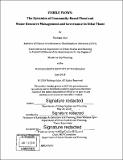| dc.contributor.advisor | Anne Whiston Spirn. | en_US |
| dc.contributor.author | Jular, Pitchapa. | en_US |
| dc.contributor.other | Massachusetts Institute of Technology. Department of Urban Studies and Planning. | en_US |
| dc.coverage.spatial | a-th--- | en_US |
| dc.date.accessioned | 2020-01-23T17:00:53Z | |
| dc.date.available | 2020-01-23T17:00:53Z | |
| dc.date.copyright | 2018 | en_US |
| dc.date.issued | 2018 | en_US |
| dc.identifier.uri | https://hdl.handle.net/1721.1/123623 | |
| dc.description | Thesis: M.C.P., Massachusetts Institute of Technology, Department of Urban Studies and Planning, 2018 | en_US |
| dc.description | Cataloged from PDF version of thesis. | en_US |
| dc.description | Includes bibliographical references (pages 101-105). | en_US |
| dc.description.abstract | In Thailand, centralized vertical governance with its 'line-of-command' approach continues to hamper holistic integration of water resource and flood management. In addition, the capacity of small-scale community actors and self-organized entities are not visible to the central bureaucrats. Using the mega 2011 flood as the baseline example, the four chapters of the documentary film,'Visible Flows', are the synthesis of both formal, and informal conversations given by the Hart Thanong community who devised strategies to mitigate flood impacts with less reliance on external assistance, and continue to do so in the present. Conducted from 19th December of 2017 to 4th February of 2018, the discovery of the values, knowledge and actions embedded within these individuals demonstrated a paradigm shift for the water resource and flood management adaptation strategies in several ways. Firstly, it reframes the notion of crisis as opportunity, beyond embracing uncertainties as norms. Secondly, it demonstrates that a fully adaptive strategy requires highly collaborative organizational arrangement, through both formal and informal rules, based on iterative processes and continual development. Lastly, self-governance is central to increasing adaptive capacity in uncertain times. Documentary film is a powerful medium to digest serious knowledge and insights of the individuals and the collectives. With the intention to bring about voices that are often invisible and marginalized in the water resource and flood management arena, the community members of the Hart Thanong Municipality, Thailand, become our educators, researchers and storytellers for this thesis. Using visual research of documentary video as the tool of investigation, I seek to understand the underlying structure that has led them to successful adaptation in order to prioritize collective actions in the water resource and flood management framework. | en_US |
| dc.description.statementofresponsibility | by Pitchapa Jular. | en_US |
| dc.format.extent | 105 pages | en_US |
| dc.language.iso | eng | en_US |
| dc.publisher | Massachusetts Institute of Technology | en_US |
| dc.relation.requires | System requirements: Windows and CD-ROM drive. | en_US |
| dc.rights | MIT theses are protected by copyright. They may be viewed, downloaded, or printed from this source but further reproduction or distribution in any format is prohibited without written permission. | en_US |
| dc.rights.uri | http://dspace.mit.edu/handle/1721.1/7582 | en_US |
| dc.subject | Urban Studies and Planning. | en_US |
| dc.title | Visible flows : the dynamics of community-based flood and water resource management and governance in Uthai Thani | en_US |
| dc.title.alternative | Dynamics of community-based flood and water resource management and governance in Uthai Thani | en_US |
| dc.type | Thesis | en_US |
| dc.description.degree | M.C.P. | en_US |
| dc.contributor.department | Massachusetts Institute of Technology. Department of Urban Studies and Planning | en_US |
| dc.identifier.oclc | 1135985039 | en_US |
| dc.description.collection | M.C.P. Massachusetts Institute of Technology, Department of Urban Studies and Planning | en_US |
| dspace.imported | 2020-01-23T17:00:52Z | en_US |
| mit.thesis.degree | Master | en_US |
| mit.thesis.department | UrbStud | en_US |
